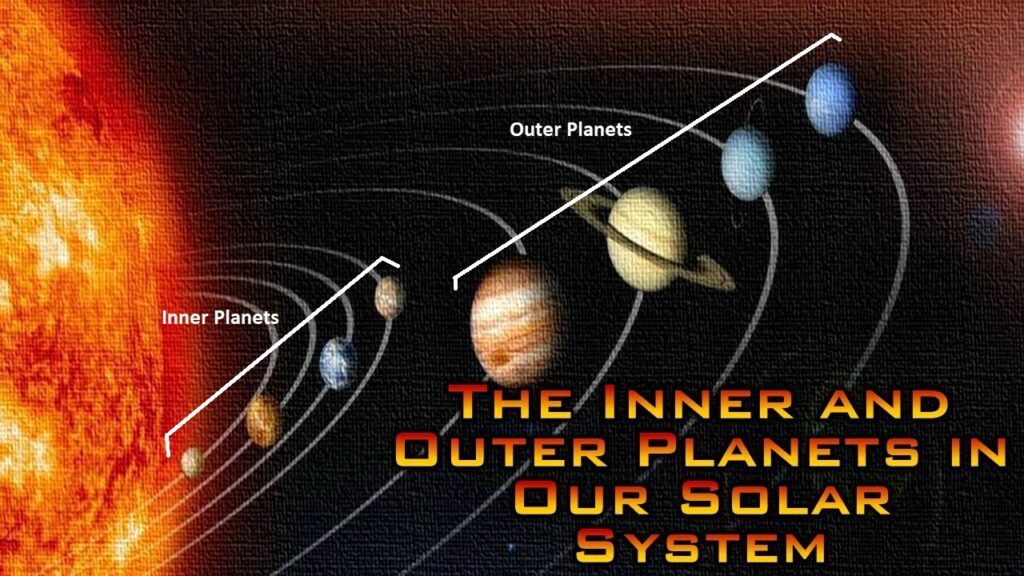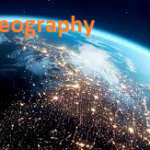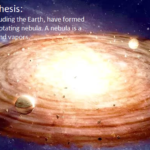Solar System
Solar System and Planets of the Solar System are of greater importance in science studies. The Earth on which we live, and the only known abode of living creatures is a planet, which is a member of the Solar System. Eight planets and the Sun are the main bodies of the Solar System. All these planets revolve around the Sun in their fixed orbits. Their motion is balanced due to a centripetal force (caused by the gravitational attraction between the Sun and planets), and centrifugal force (caused by their rotational motion). The planets in order of distance from the Sun are; Mercury, Venus, Earth, Mars, Jupiter, Saturn, Uranus, Neptune, and Pluto (expelled out of the status of planet, and downgraded as a dwarf planet). Each planet moves around the Sun and maintains an elliptical orbit. The orbits of all the planets are almost in the same plane, which is close to the equatorial plane of the Sun. The planets also rotate about their own axes. About 99.85 % of the total mass of the Solar system is contained within the Sun, while all the planets collectively make up 0.15% of the total mass of the Solar System. On the basis of their location, the planets can be divided into two groups; (i) the inner planets, and (ii) the outer planets.
Inner Planets:
Our Solar System is a marvelous place, with plenty of physical features and governed by complex natural principles and phenomena. Among its eight planets, 5 known dwarf planets (possibly hundreds more), 176 moons of different sizes, 659,212, so far known asteroids, and 3,296 known comets, developed great curiosities in the human mind. This system is composed of different regions, which are categorized and delineated based on their distance from the Sun, but also the types of planets and bodies that can be found within them.
In the interior region of the Solar System, we find four “Inner Planets” – Mercury, Venus, Earth, and Mars – which are so named because they orbit closest to the Sun. Apart from their proximity, these planets have a number of key differences that set them apart from planets elsewhere in the Solar System.
Meanwhile, the inner planets are terrestrial and rocky meaning that they are solid and composed mostly of silicates and metals like iron, nickel, magnesium, aluminum, and so on. But on the other hand, the outer planets are giants composed mostly of gases. The inner planets are less distant from one another if compared to their outer Solar System counterparts. For example, the radius of the entire inner region is less than the distance between the orbits of Jupiter and Saturn.
The inner region lies within the frost line. The frost line is the boundary of a Solar system in which the temperature is reasonably warm, and hydrogen compounds like water, methane, and ammonia can retain their liquid state. The frost line lies at a distance of 5 Astronomical Units (700 million km) from the Sun. Beyond the frost line, the hydrogen compounds condense into ice grains, meaning that the temperature is too low out there. Some scientists refer to the frost line as the Goldilocks Zone (habitable zone), which is appropriate for life.

Mercury: Mercury is the planet closest to the Sun. This very small planet looks quite identical to Earth’s Moon in color and shape. Like the moon, it has many deep craters and is covered by a thin layer of tiny particle silicates.
Its magnetic field is only about 1 percent that of Earth, and it has a very thin atmosphere means that it is hot during the day (temperature may rise up to 430°C) and freezing at night (temperature may fall up to -187 °C) because the ability of atmosphere to retain either heat or coldness is very low. Mercury is mainly composed of iron and nickel metal. It has no moon. It is fastest fastest-revolving planet in the solar system. The year on Mercury is only 88 days long.
Venus: The second distant planet in the Solar system is Venus, which is about the same size as Earth, and has a thick toxic atmospheric layer that absorbs and traps tremendous amounts of solar heat, making it the hottest planet in the Solar System. 96% atmosphere of Venus is composed of carbon dioxide, and the remaining 4 % is composed of Nitrogen and a few other gases. The atmosphere is filled with dense clouds of sulphuric acid and other corrosive compounds, with very litter water.
It is quite difficult to penetrate the thick atmosphere of Venus, and so far only two spacecraft have ever penetrated it. Even natural objects can not cross the atmosphere without being disintegrated, this is why there are very few craters on the surface of Venus.
Venus is known as the morning star because it is the last celestial to disappear from the sky at sunrise. It is known as the evening star because it is the first celestial body to become visible in the sky in the evening.
Moreover, Venus has a moon of its own. Venus is certainly considered very odd for spinning in the opposite direction to most other planets, but the strangeness of Venus doesn’t end there. The planet rotates incredibly slowly, with the Venusian day equivalent to 243 Earth days, which is longer than the Venusian year of 225 Earth days.
Earth: Earth is the third distant planet of the Solar system, and is included in the group of inner planets because of similar characteristics. It is the planet we know best. Of the four terrestrial planets, Earth is the largest, and the only one that currently has liquid water, which made life possible on it. Earth’s atmosphere has multi-layers, and each has its own significance. It has an ozone layer, which protects the planet from dangerous radiation and helps keep valuable sunlight and warmth in, which is also essential for life to survive.
Like Mercury and Venus, Earth has a solid rocky surface with mountains and canyons and a heavy metal core. Earth has a humid atmosphere, which helps to moderate daily temperatures. Like Mercury, the Earth has an internal magnetic field. Our Earth has a beautiful Moon, comprised of a mixture of various substances including metals and precious material.
Mars: Also known as the “Red Planet”, it is the fourth distant planet of the Solar System and the fourth member of the Inner Group. Its surface is red due to the rust of iron-rich materials that form the planet’s surface. Mars has some of the most distinctive and interesting features like it has the largest mountain (Olympus Mons) in the Solar System, on it. Olympus Mons rises some 21,229 m (69,649 ft) above the surface, which is 2.5 times higher than Mount Everest. Mars has a giant canyon called Valles Marineris. Valles Marineris is 4000 km long and reaches depths of up to 7 km, which is five times longer and deeper than the Grand Canyon of Arizona.
Much of the Martian surface is very old and filled with craters, but there are geologically newer areas of the planet as well.
Due to internal magnetic fields, Mars has poles, which are covered with polar ice caps that shrink in size during the Martian spring and summer. Mars is less dense than Earth and has a smaller magnetic field, which is indicative of a solid core, rather than a liquid one.
Mars’ thin atmosphere has led some astronomers to believe that the surface water that once existed there might have actually taken liquid form, but has since evaporated into space. The planet has two small moons called Phobos and Deimos.
Outer Planets:
Beyond Mars (the last inner planet) are the four outer planets- Jupiter, Saturn, Uranus, and Neptune. These four planets are known as the outer planets. Being is larger in size, they are known as gaints. They are so larger in size and mass than the inner planets that they make up 99 percent of the mass of the celestial bodies that orbit the Sun. They are mainly composed of gaseous material, but still have other solid and liquid ingredients. Scientists assume that at the center they must have a rocky core comprised of heavy metals. Among these planets Jupiter is the largest and three hundred times larger than our Earth.
Jupiter: Jupiter is the fifth distant planet of the Solar System. It is the largest planet, which is three hundred time massive than Earth. Jupiter is not only the largest planet, but it also has the most moons. i.e 63 so far known moons. Jupiter is one of the brightest objects in the sky and has a very stormy atmosphere. One major storm is the Great Red Spot. The size of the Red Spot is as big as that of the Earth.
Saturn: Saturn has many distinctive, large and clearly visible rings. Although all of the outer planets have rings around them, but those of the Saturn are very clearly visible. Before 1977, the only known rigns were of the Saturn, untill the discovery of rings around Jupiter and Neptune.
Uranus: The smallest planet out of Outer group is Uranus. It is smallest in mass but a bit bigger than Neptune in size. One day on Uranus takes about 17 hours (the time it takes for Uranus to rotate or spin once). And Uranus makes a complete orbit around the Sun (a year in Uranian time) in about 84 Earth years (30,687 Earth days). It is the only planet to rotate on its side. Scientists are unsure why it rotates that way, although there are a couple of theories. One suggests it suffered a major collision and another hypothesizes that smaller shifts during the planet’s formation caused its unusual rotation.
Neptune: Neptune is the last and outermost planet in the solar system. Neptune’s winds are the fastest of any planets in the Solar System and their velocity can reach up to 1,200 miles per hour. Although all of the outer planets’ atmospheres contain hydrogen and helium, but Neptune and Uranus contain significant amounts frozen water, ammonia, and methane. The colour of the planet is blue due to the presence of methane.
Difference Between the Inner and the Outer Planets
The planets of the two groups differ markedly in size, density, composition, and rate of rotation.
Size: The members of the inner planet group are small in size, while the outer planets are comparatively larger, and therefore they are often called giants. The size difference between the two groups is so high that Jupiter being the largest planet in the solar system, has a diameter of approximately 9104 miles, while on the other hand, Mercury being the smallest planet in the solar system, has a diameter of approximately 3103 miles.
Density: The inner planets are generally denser than the outer planets. The density of outer planets is much lower. For example, the Saturn has a density less than that of water. The comparative density of all these planets is as under;
| Planet | Average Density (gm/cm3) | Required Mass for 100 cm3 (gm) |
|---|---|---|
| Mercury | 5.4 | 540.0 gm |
| Venus | 5.2 | 520.0 gm |
| Earth | 5.5 | 550.0 gm |
| Mars | 3.9 | 390.0 gm |
| Jupiter | 1.3 | 130.0 gm |
| Saturn | 0.7 | 70.0 gm |
| Uranus | 1.3 | 130.0 gm |
| Neptune | 1.6 | 160.0 gm |
Composition: The lower density of the outer planets suggests that they consist mostly of substances, like hydrogen, helium, water, ammonia, and methane. The high-density planets consist almost entirely of silicate and metals.
Rate of Orbital Speed: The planet Mercury is nearest to the Sun. It has the fastest orbital motion which is 48 km/sec, and the shortest period of revolution, which is 88 days. Neptune, being the most distant planet has an orbital speed of 5.43 km/sec. Neptune requires 164 Earthen years to complete one revolution around the Sun. Similarly, the revolution speed of Pluto is only 5.0 km/sec and thus requires 248 Earthen years to complete its single revolution around the sun.
Number of Moons: The inner planets have either fewer or no moons at all, while the outer planets have a greater number of moons. For example, Mercury and Venus have no moons, Earth has one moon, and Mars has two small moons. On the other hand, the gas giants Jupiter and Saturn and the ice giants Uranus and Neptune have dozens of moons. Jupiter has 79, Saturn 82, Uranus 27, Neptune 14, and Pluto has 5 of varying sizes, shapes, and properties.
Mineral Compositions: The terrestrial/ rocky inner planets are composed largely of refractory minerals, such as silicates, which form their crusts and mantles, and metals such as iron and nickel which constitute their cores. Three of the four inner planets (Venus, Earth, and Mars) have atmospheres substantial enough to generate weather. All of them have impact craters and tectonic surface features as well, such as rift valleys and volcanoes. This is because of their hot interior.
You may like: A comprehensive introduction to Geography


Leave a Reply